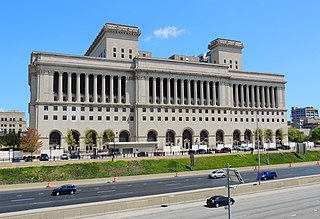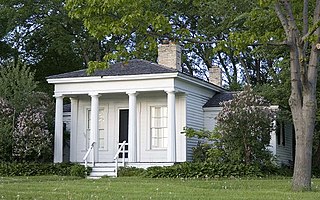
The Milwaukee Bridge War, sometimes simply the Bridge War, was an 1845 conflict between people from different regions of what is now the city of Milwaukee, Wisconsin, over the construction of a bridge crossing the Milwaukee River. [1] [2]

The Milwaukee Bridge War, sometimes simply the Bridge War, was an 1845 conflict between people from different regions of what is now the city of Milwaukee, Wisconsin, over the construction of a bridge crossing the Milwaukee River. [1] [2]
The area that is now the city of Milwaukee was originally home to three settlements: Solomon Juneau's Juneautown, founded on the east side of the Milwaukee River in 1818; Byron Kilbourn's Kilbourntown on the west side of the river, founded in 1834; and Walker's Point to the south, founded by George H. Walker also in 1834. [3]
The early history of Milwaukee was marked by the rivalry between Juneautown and Kilbourntown, mostly due to the actions of Byron Kilbourn. Kilbourn had been trying to isolate Juneautown to make it more dependent on Kilbourntown. For example, when he laid out his street grid in 1835, he paid no attention to the existing street layout of Juneautown. Kilbourn's maps showed Juneautown as a blank space, and when steamers delivered goods to Kilbourn's west side docks, he ordered the captains to tell passengers that Juneautown was an Indian trading post. [3] The three areas were incorporated into the village of Milwaukee in 1839. [3]
In 1840, the Wisconsin Territorial Legislature, finding the ferry system on the Milwaukee River to be "inadequate", ordered the construction of a bridge. This first bridge was built over Chestnut Street (now Juneau), with Solomon Juneau's support. [3] That same year Kilbourn built a bridge across the Menomonee River. Three more bridges were built over the Milwaukee: at Spring Street (now Wisconsin) in 1842, at Oneida (now Wells) in 1844, and one between Walker's Point and Juneautown at North Water Street. Kilbourn was opposed to the Chestnut, Oneida, and North Water bridges, as he felt they would be a hazard to ships visiting his docks. [3]
On 3 May 1845, a schooner rammed into the Spring Street bridge, the only one that was supported by Kilbourn. Rumors spread that east ward residents, angry at the west warders for refusing to pay for bridge maintenance, had paid the schooner's captain to damage the Spring Street bridge. West warders held a meeting and decided that the Chestnut Street bridge (supported by Solomon Juneau) had become an "insupportable nuisance". The west warders gathered tools and took down the west half of the Chestnut street bridge, collapsing it. [3] Angry east warders gathered weapons, including an old cannon (loaded only with clock weights) that they rolled up to the east side of the river. The cannon was aimed at Kilbourn's home, but the east warders held their fire when they learned that Kilbourn's young daughter had just died. [3]
The village trustees voted to remove the Oneida bridge and use the pieces to repair the Spring Street bridge. This would have removed both of the east warders' preferred bridges. Angered by this, east warders gathered on 28 May and destroyed the Spring Street bridge, followed by the bridge on the Menomonee. [3]
The next few weeks were tense: east and west warders on the "wrong side" of the river were attacked and injured, east warders spread rumors of an attack on Kilbourn's Milwaukee river dam, and by early June the trustees ordered that all bridge work be done under armed guard. [3]
Tempers slowly cooled as the year went on. In December, the trustees put together a plan for three new bridges, and drafted a city charter. Finally, on 31 January 1846, the city of Milwaukee was formed. [3]
An echo of the differences between east and west Milwaukee can still be seen today. Many of the modern bridges across the Milwaukee River run at an angle, reflecting the difference in the street layouts between what was once Juneautown and Kilbourntown. [3]

Milwaukee, officially the City of Milwaukee, is the most populated city in the U.S. state of Wisconsin and the county seat of Milwaukee County. With a population of 577,222 at the 2020 census, Milwaukee is the 31st largest city in the United States, the fifth-largest city in the Midwestern United States, and the second largest city on Lake Michigan's shore behind Chicago.

Solomon Laurent Juneau, or Laurent-Salomon Juneau was a French Canadian fur trader, land speculator, and politician who helped found the city of Milwaukee, Wisconsin. He was born in Repentigny, Quebec, Canada to François and (Marie-)Thérèse Galarneau Juneau. His cousin was Joseph Juneau, who founded the city of Juneau, Alaska.

The Milwaukee River is a river in the state of Wisconsin. It is about 104 miles (167 km) long. Once a locus of industry, the river is now the center of a housing boom. New condos now crowd the downtown and harbor districts of Milwaukee attracting young professionals to the area. The river is also ribboned with parks as it winds through various neighborhoods. Kayaks and fishing boats share the river with party boats. An extensive Riverwalk featuring art displays, boat launches and restaurants lines its banks in downtown Milwaukee.
The history of Wisconsin encompasses the story not only of the people who have lived in Wisconsin since it became a state of the U.S., but also that of the Native American tribes who made their homeland in Wisconsin, the French and British colonists who were the first Europeans to live there, and the American settlers who lived in Wisconsin when it was a territory.

Byron Kilbourn was an American surveyor, railroad executive, and politician who was an important figure in the founding of Milwaukee, Wisconsin. He was the 3rd and 8th mayor of Milwaukee.

George H. Walker was an American trader and politician, and was one of three key founders of the city of Milwaukee, Wisconsin. He served as the 5th and 7th Mayor of Milwaukee, and represented Milwaukee in the Wisconsin State Assembly and its predecessor body in the Wisconsin Territory.

The Milwaukee County Courthouse is a high-rise municipal building located in downtown Milwaukee, Wisconsin. Completed in 1931, it is the third county courthouse built in the city and is listed on the National Register of Historic Places.

Summerfield United Methodist Church is located in the historic Juneautown neighborhood of downtown Milwaukee, Wisconsin. Part of the United Methodist Church (UMC), Summerfield has established several community missions and promotes social justice.

The Menomonee Valley or Menomonee River Valley is a U-shaped land formation along the southern bend of the Menomonee River in Milwaukee, Wisconsin. Because of its easy access to Lake Michigan and other waterways, the neighborhood has historically been home to the city's stockyards, rendering plants, shipping, and other heavy industry. It was also a primary source of pollution for the river.
Hans Crocker was an American lawyer and Wisconsin politician.

The neighborhoods of Milwaukee include a number of areas in southeastern Wisconsin within the state's largest city at nearly 600,000 residents.

The Benjamin Church House, a modestly sized Temple-style Greek Revival home, was built in 1843–1844 by a pioneer carpenter of that name in Kilbourntown, a settlement on the west side of the Milwaukee River. In 1846, Kilbourntown merged with Juneautown on the east side of the river and Walker's Point to the south to create Milwaukee, today the largest city in Wisconsin. The house is thought to be Milwaukee's earliest surviving home.
Milwaukee, Wisconsin's history, which includes over 160 years of immigration, politics, and industry, has given it a distinctive heritage.

The Milwaukee County Historical Society, also known as MCHS, is a local historical society in Milwaukee County, Wisconsin. Founded in 1935, the organization was formed to preserve, collect, recognize, and make available materials related to Milwaukee County history. It is located in downtown Milwaukee in the former Second Ward Savings Bank building.

William Augustus Prentiss was an American merchant, Republican politician, and Wisconsin pioneer. He played an important role in creating the city of Milwaukee, Wisconsin, and was the 10th mayor of that city. He also served in the Vermont House of Representatives, the 2nd Wisconsin Territorial Assembly, and the Wisconsin State Assembly.

The Martin Drive neighborhood of Milwaukee is a residential district on the west side of the city. It is named for the local 19th-century politician Morgan Lewis Martin. Housing development started in the 1920s around two breweries. The area has benefited from local improvement programs and community activities since the 1990s.
Benjamin F. Church (1807–1887) was a pioneer carpenter and builder in Milwaukee, Wisconsin, USA, listed among the city's first settlers of 1835. He helped to construct one of the city's first two big hotels and built a Greek Revival temple-style house for his family that today is a public museum in Estabrook Park, Shorewood, Wisconsin. He also held varied public offices and volunteer roles in the young city.

The Old World Third Street Historic District is the last relatively intact part of the original German retail district in Milwaukee, Wisconsin's Kilbourntown plat, containing examples of various styles of Victorian commercial architecture going back to 1855. It was listed on the National Register of Historic Places in 1987 and on the State Register of Historic Places in 1989.

The Walker's Point Historic District is a mixed working-class neighborhood of homes, stores, churches and factories in Milwaukee, Wisconsin, with surviving buildings as old as 1849, including remnants of the Philip Best Brewery and the Pfister and Vogel Tannery. In 1978 it was added to the National Register of Historic Places. The NRHP nomination points out that Walker's Point was "the only part of Milwaukee's three original Settlements to reach the last quarter of the Twentieth Century with its Nineteenth and early-Twentieth Century fabric still largely intact," and ventures that "For something similar, one would have to travel to Cleveland or St. Louis if, indeed, so cohesive and broad a grouping of...structures still exists even in those cities."

Downtown Milwaukee is the central business district of Milwaukee, Wisconsin. The economic and symbolic center of the city and the Milwaukee metropolitan area, it is Milwaukee's oldest district and home to many of region's cultural, financial educational and historical landmarks including Milwaukee City Hall, Fiserv Forum and the Milwaukee Art Museum. The city's modern history began in Downtown Milwaukee in 1795 when fur trader Jacques Vieau (1757–1852) built a post along a bluff on the east side, overlooking the Milwaukee and Menomonee rivers.